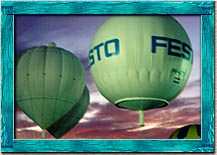nh1476@bristol.ac.uk
School of Chemistry
University of Bristol
Lighter than air
|
Chemists Montgolfier brothers Gas balloons Airships and blimps Modern hot air balloons Rozier balloons Special shapes |
Gas Balloons

|

|
| http://www.westward.com/gallery/exhib07f.htm |
Gas balloons are used for entertainment as shown above, but also have various scientific applications. Large, unmanned helium balloons provide NASA with an inexpensive means to place machinery into a space environment. Many important scientific observations are made from balloons, including x-ray and infra-red astronomy as well as a range of atmospheric studies. Recent technological developments mean that long duration ballooning is more feasible which has greatly expanded the usefulness of balloons.
Jacques Charles
Charles made the first balloon of hydrogen gas. On August 27th, 1783, his first balloon, only four metres in diameter, was launched from the Champs de Mars in Paris. The balloon was made of silk covered in rubber solution to make it air tight. After a flight of 45 minutes the balloon descended into a small village where local farmers attacked the "monster" with axes and spades.
Even after ballooning became more popular across Europe over the following years, village people continued to be frightened by the strange objects descending from the heavens. Early aeronauts began to carry champagne on board to present to farmers on landing. It is now a well established tradition to carry champagne on maiden flights.
Charles may have been trying to imitate the Montgolfier brothers, but he had emerged with a completely different way of creating a gas that will rise through the air. The Montgolfiers believed that they were creating a "Montgolfier gas" by heating the air, whereas Charles was forming a similar gas from acid and iron filings. Similar in the way that both caused a balloon filled with the gas to rise into the air. Hot air and hydrogen both rise as they are less dense than air itself but they are not the same thing, which was not realised by the innovators at the time.
Gas balloons soon took over the skies from the primitive hot air balloons, later evolving into airships and other similar craft.